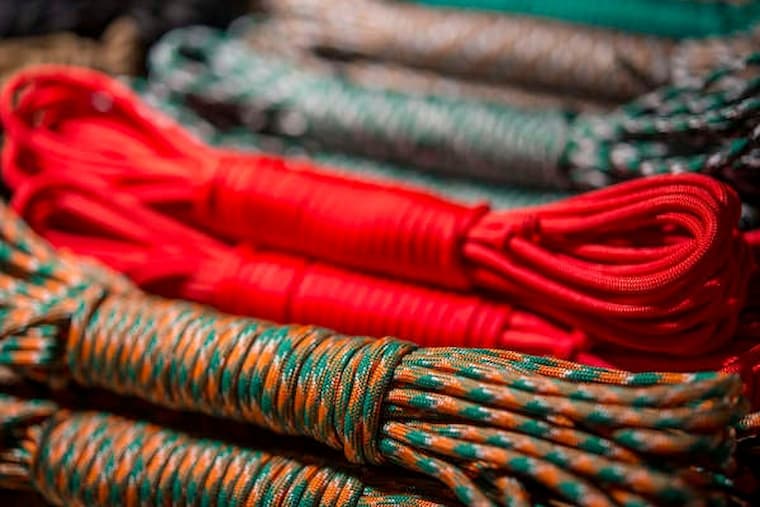Sports
Parachute Cord Rope: Must-Have for Any Outdoor Enthusiast

If there’s one thing that every hiker, soldier, and scout can agree on, it’s this: that rope is an absolute necessity whenever you’re outdoors. Whether it’s for stabilizing a tent, hanging food or other items up and out of the way of curious critters, or pulling a load of gear up an incline, a good length of rope is as essential as a knife when you’re facing off against nature.
That same length of rope is also just as valuable for strapping a piece of furniture down on your trailer or securing material at a construction site. Suffice it to say, having a couple of metres of rope around is just as important in the city as it is in the outback.
There are literally dozens of types of twisted and braided rope being produced for every conceivable purpose. But for most people, the ideal rope to have is the one that’s lightweight enough to barely even notice that they have it, yet more than strong enough for any job they’re likely to encounter. There’s one type of commercially available rope that checks both of those boxes, and you can get your hands on it anytime.
The paracord preference
Let’s be honest: it’s easy to overlook the exact qualities that go into manufacturing a sturdy piece of rope. Lightweight and strong are good starting points, but what about its elasticity, or its resistance to heat or moisture? When all of these factors matter, you want paracord, the commercial equivalent to parachute cord rope that’s just as suitable for casual hobby and recreational use, as it is for serious repair work and outdoor activities.
Paracord’s versatility comes from a composition that encases a high-strength core of twisted rope strands inside a 32-strand braided outer sleeve. This unique composition, known as a kernmantle-style rope, has its roots in U.S. Army rope specifications where tensile strength and tensile elongation were required to be the dominant qualities. For modern commercial purposes though, paracord has had to evolve to include a range of applications that are a long way from their military origins.
There are six types of paracord rope, and all possess a 30% elongation rate but with varying tensile strength ratings and inner core strand counts:

Tensile Strength Core Stranding Type I 95lbs / 43kg 4 – 7
Type IA 100lbs / 46kg 4 – 7
Type II 400lbs / 181kg 4 – 7
Type IIA 225lbs / 100kg 4 – 7
Type III 550lbs / 249kg 7 – 9
Type IV 750lbs / 341kg 11
Commercial versions of Types I, III, and IV are widely sold and used for all kinds of purposes but it’s Type III, however, with its ideal balance of strength and durability that enjoys the highest degree of preference among outdoorsmen. Weighing only 7 grams/metre, and sold in 30 metre bundles and on 300 metre spools, Type III’s full-weight usage as an all-purpose outdoor rope is no less remarkable than its stripped-weight usage for fishing line. So, if you’re contemplating which size of rope you could potentially get the most regular use out of, Type III it is.
Longer lasting paracord
Regardless of whether you’re using the 3/64” (1.18mm) micro-sized Type IA cord to tie up your laundry, or the beefier 5/32” (4mm) Type III to tie up your boat, you’re still getting the same high-quality rope that’s true to its military origins. In fact, when it comes to construction, the commercial paracord rope for sale in some ways takes the original Mil-Spec variant just a bit further.
Original spec paracord features all-nylon construction, while commercial paracord is comprised of a nylon/polyester blend. Nylon stretches well and compresses easily, but the blend’s advantages over pure nylon actually equate to a significant improvement in both performance and reliability, including:
· Less stretch and greater rigidity, especially when wet;
· Higher resistance to rot and UV exposure; and,
· Greater resistance to damage due to abrasion.
You can also find paracord cord rope online in a broad range of reflective, no-run colours that boggle the mind: a great precautionary attribute to have in the event of an emergency. Of course, you’ll also find paracord in the standard collection of tactical rope colours too, but the fact that it’s available in so many colours speaks volumes for its versatility.
Because it’s built for a wider range of uses, commercial paracord is both more adaptable and longer lasting than its military equivalent; and the more uses you find for it, the more you’ll recognize the benefits.

Safety First
Although it’s not difficult to point out the virtues of paracord ropes, it’s absolutely crucial to also be aware of its limits.
When you’re looking at the tensile strength of a paracord-type rope. or any rope for that matter, you want to remember that the number you’re looking at is a static load rate. Using Type III rope as an example, it means that while it’s technically capable of supporting a stationary load of 550lb above the ground, don’t expect it to support the same load if it was tossed over the side of a cliff.
Dynamic loading is the reason why Army parachutists, the guys for whom genuine paracord was invented for, ultimately depend on so many suspension lines in the first place. A single line of paracord, Mil-Spec or civilian, isn’t designed for jumping, rappelling, climbing, or any other activity where the static load’s working weight (its working load) would exceed the rope’s tensile strength by more than 1/3.
Make no mistake, civilian paracord is incredibly good at what it does, but don’t ignore the risks that are presented to personal safety by overloading any kind of rope.

The conclusion
At the end of the day, there’s no question about the importance of ensuring that you’ve packed a quantity of rope with you whenever you’re preparing to head for the outdoors. And what emergency preparedness, roadside kit, or garage would be complete without a roll as well?
When it comes to a rope that’s stronger, and simply more versatile and reliable than any of its contemporaries, commercial paracord is the parachute rope that pretty much does everything. It’s the rope you know you can count on, no matter what you’re likely to encounter.











